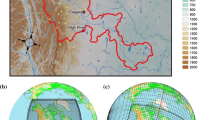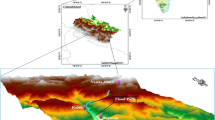Abstract
In 2022, a catastrophic flood triggered by the extreme precipitation in Sind Province, Pakistan. To better understand the comprehensive response of water vapor, rainfall, topography, and flood, the source of water vapor for the flood was calculated by the NCAR Command Language (NCL) application. Simultaneously, the Global Precipitation Measurement (GPM) data was collected from NASA for overlay analysis with water vapor observations. In addition, a digital elevation model (DEM) was also obtained to analyze the impact of topography on flood inundation. Importantly, multi Sentinel-1 data was used to monitor the long-term changes in flood inundation area. The extreme precipitation is dominated by water vapor continue transferred by southwest monsoon, especially impacted by the occurrence of cyclone. Simultaneously, influenced by the steep terrain that located in the north and west of Pakistan, the extreme precipitation first occurred in Islamabad and its adjacent area, subsequently in Punjab Province, and finally concentrated in Sind Province. The surface runoff induced by rainstorm converged in the junction of Sind and Punjab Province with the pattern of fire hose effect. Subsequently, the flood in Indus River in the Sind Province overflow into the low-lying area along the bank of Indus River due to the terrain of Indus River in these regions has the characteristics of over ground river, and the flood flow capacity is lower than that in northern of Pakistan. In addition, the long-term changes in the flood inundation area can be summarized into four stages: increase slowly period (In June), increase slightly period (In July), increase rapidly period (Between August and the beginning of September), rapidly decline period (After September 15, 2022). Importantly, a conceptual model of disaster caused by the fire pipe effect is summarized based on the comprehensive response of water vapor, rainfall, and topography.


















Similar content being viewed by others
References
Abbaspour KC, Yang J, Maximov I, Siber R, Bogner K, Mieleitner J, Zobrist J, Srinivasan R (2007) Modelling hydrology and water quality in the pre-alpine/alpine Thur watershed using SWAT. J Hydrol 333:413–430. https://doi.org/10.1016/j.jhydrol.2006.09.014
Bates PD, Horritt MS, Smith CN, Mason D (1997) Integrating Remote Sensing Observations Of Flood Hydrology And Hydraulic Modelling. Hydrol Process 11: 1777–1795. https://doi.org/10.1002/(SICI)1099-1085(199711)11:14<1777::AID-HYP543>3.0.CO;2-E
Chen HY, Cui P, Chen XQ, Tang JB (2017) Study on the surge wave induced by glacier avalanches and its effects on dam failure process. International Journal of Erosion Control Engineering 10(1):9–15. https://doi.org/10.13101/ijece.10.9
Chen B, Xu XD, Zhao T (2018) Quantifying oceanic moisture exports to mainland China in association with summer precipitation. Clim Dynam 51:4271–4286. https://doi.org/10.1007/s00382-017-3925-1
Chen H, Ruan H, Chen J, Li X, Yu Y (2022) Review of investigations on hazard chain triggered by river-blocking debris flows. Front Earth Sc-Switz 10(16):830044. https://doi.org/10.3389/feart.2022.830044
Chu QC, Wang QG, Feng GL (2017) Determination of the major moisture sources of cumulative effect of torrential rain events during the preflood season over South China using a Lagrangian particle model. J Geophys Res-Atmos 122:8369–8382. https://doi.org/10.1002/2016JD026426
Coe JA, Glancy PA, Whitney JW (1997) Volumetric analysis and hydrologic characterization of a modem debris flow near Yucca Mountain, Nevada. Geomorphology 20:11–28. https://doi.org/10.1016/S0169-555X(97)00008-1
D’Addabbo A, Refice A, Pasquariello G, Lovergine FP, Capolongo D, Manfreda S (2016) A Bayesian network for flood detection combining SAR imagery and ancillary data. IEEE T Geosci Remote 54(6):1–14. https://doi.org/10.1109/TGRS.2016.2520487
Dai FC, Lee CF, Deng JH, Tham LG (2006) The 1786 earthquake-triggered landslide dam and subsequent dam-break flood on the Dadu River, southwestern China. Geomorphology 73(3–4):277–278. https://doi.org/10.1016/j.geomorph.2005.04.017
Deng MZ (2021) Temporal and spatial variation characteristics of air temperature and precipitation and the applicability of reanalysis data in Pakistan. Xinjiang Normal University, Urumqi, Xinjiang. (In Chinese)
Eekhout JPC, Boix-Fayos C, Pérez-Cutillas P, Vente JD (2020) The impact of reservoir construction and changes in land use and climate on ecosystem services in a large Mediterranean catchment. J Hhydrol 590:125208. https://doi.org/10.1016/j.jhydrol.2020.125208
Franci F, Bitelli G, Mandanici E, Hadjimitsis D, Agapiou A (2016) Satellite remote sensing and GIS-based multi-criteria analysis for flood hazard mapping. Nat Hazards 83:S31–S51. https://doi.org/10.1007/s11069-016-2504-9
Griffiths PG, Webb RH (2004) Frequency and initiation of debris flows in Grand Canyon. Arizona J Geophys Res 109:F04002. https://doi.org/10.1029/2003JF000077
Hersbach H, Bell B, Berrisford P, Biavati G, Horányi A, Muñoz Sabater J, Nicolas J, Peubey C, Radu R, Rozum I, Schepers D, Simmons A, Soci C, Dee D, Thépaut JN (2019) ERA5 monthly averaged data on single levels from 1959 to present. Copernicus Climate Change Service (C3S) Climate Data Store (CDS). https://cds.climate.copernicus.eu/cdsapp#!/dataset/reanalysis-era5-single-levels-monthly-means?tab=form
Hondula DM, Sitka L, Davis RE, Knight DB, Gawtry SD, Deaton ML, Lee TR, Normile CP, Stenger PJ (2010) A back-trajectory and air mass climatology for the Northern Shenandoah Valley, USA. Int J Climatol 30:569–581. https://doi.org/10.1002/joc.1896
Houze RA Jr, Rasmussen KL, Medina S, Brodzik SR, Romatschke U (2011) Anomalous atmospheric events leading to the summer 2010 floods in Pakistan. B Am Meteorol Soc 92(3):291–298. https://doi.org/10.1175/2010BAMS3173.1
James P, Stohl A, Spichtinger N, Eckhardt S, Forster C (2004) Climatological aspects of the extreme European rainfall of August 2002 and a trajectory method for estimating the associated evaporative source regions. Nat Hazard Earth Sys 4:733–746. https://doi.org/10.5194/nhess-4-733-2004
Khan SI, Hong Y, Wang J, Yilmaz KK, Gourley JJ, Adler RF, Brakenridge GR, Policelli F, Habib S, Irwin D (2011) Satellite remote sensing and hydrologic modeling for flood inundation mapping in Lake Victoria basin: implications for hydrologic prediction in ungauged basins. IEEE T Geosci Remote 49(1):85–95. https://doi.org/10.1109/TGRS.2010.2057513
Liu Y, Qiu H, Kamp U, Wang N, Wang J, Huang C, Tang B (2024) Higher temperature sensitivity of retrogressive thaw slump activity in the Arctic compared to the Third Pole. Sci Total Environ 914(6611):170007. https://doi.org/10.1016/j.scitotenv.2024.170007
Marras PA, Lima DCA, Soares PMM, Cardoso RM, Medas D, Dore E, Giudici GD (2021) Future precipitation in a Mediterranean island and streamflow changes for a small basin using EURO-CORDEX regional climate simulations and the SWAT model. J Hydrol 603:127025. https://doi.org/10.1016/j.jhydrol.2021.127025
Mei H, Li YP, Lv J, Chen XJ, Lu C, Suo C, Ma Y (2021) Development of an integrated method (MGCMs-SCA-FER) for assessing the impacts of climate change – a case study of Jing-Jin-Ji region. J Environ Inform 38(2):145–161. https://doi.org/10.3808/jei.202100468
O’Brien JS, Julien PY, Fullerton WT (1993) Two-dimensional water flood and mudflow simulation. J Hydraul Eng-Asce 119:244–261. https://doi.org/10.1061/(ASCE)0733-9429(1993)119:2(244
Rana IA, Routray JK (2016) Risk assessment of flood prone urban areas of Pakistan: international conference on disaster management. In: International conference on disaster management: from polar region to the local communities at: National Institute of Development Administration (NIDA), Bangkok, Thailand
Refice A, Capolongo D, Pasquariello G, D’Addabbo A, Bovenga F, Nutricato R, Lovergine FP, Pietranera L (2014) Sar and insar for flood monitoring: examples with COSMO-SkyMed data. IEEE J-Stars 7(7):1–12. https://doi.org/10.1109/JSTARS.2014.2305165
Schoof JT, Pryor SC (2001) Downscaling temperature and precipitation: a comparison of regression-based methods and artificial neural networks. Int J Climatol 21:773–790. https://doi.org/10.1002/joc.655
Schrier GVD, Rasmijn LM, Barkmeijer J, Sterl A, Hazeleger W (2018) The 2010 Pakistan floods in a future climate. Clim Change 148:205–218. https://doi.org/10.1007/s10584-018-2173-7
Shah AA, Ye J, Abid M, Ullah R (2017) Determinants of flood risk mitigation strategies at household level: a case of Khyber Pakhtunkhwa (KP) province, Pakistan. Nat Hazards 88:415–430. https://doi.org/10.1007/s11069-017-2872-9
Siddiqui MJ, Sajjad Haider HFG, Shahzad A (2018) Rainfall–runoff, flood inundation and sensitivity analysis of the 2014 Pakistan flood in the Jhelum and Chenab river basin. Hydrolog Sci 63:13–14. https://doi.org/10.1080/02626667.2018.1546049
Tan X, Gan TY, Chen YD (2018) Moisture sources and pathways associated with the spatial variability of seasonal extreme precipitation over Canada. Clim Dynam 50:629–640. https://doi.org/10.1007/s00382-017-3630-0
Tang C, Zhu J, Li WL, Liang JT (2009) Rainfall-triggered debris flows following the Wenchuan earthquake. B Eng Geol Environ 68(2):187–194. https://doi.org/10.1007/s10064-009-0201-6
Tang C, Zhu J, Ding J, Cui XF, Chen L, Zhang JS (2011) Catastrophic debris flows triggered by a 14 August 2010 rainfall at the epicenter of the Wenchuan earthquake. Landslides 8(4):485–497. https://doi.org/10.1007/s10346-011-0269-5
Tang C, van Asch TWJ, Chang M, Chen GQ, Zhao XH, Huang XC (2012) Catastrophic debris flows on 13 August 2010 in the Qingping area, southwestern China: the combined effects of a strong earthquake and subsequent rainstorms. Geomorphology 139–140:559–576. https://doi.org/10.1016/j.geomorph.2011.12.021
Wang B, Tian F, Hu H (2011) Analysis of the effect of regional lateral inflow on the flood peak of the Three Gorges Reservoir. Sci China Technol Sc 54(4):914–923. https://doi.org/10.1007/s11431-011-4330-3
Wang X, Chen Y, Song L, Chen X, Xie H, Liu L (2013) Analysis of lengths, water areas and volumes of the Three Gorges Reservoir at different water levels using Landsat images and SRTM DEM data. Quatern Int 304:115–125. https://doi.org/10.1016/j.quaint.2013.03.041
Wang Z, Duan A, Yang S, Ullah K (2017) Atmospheric moisture budget and its regulation on the variability of summer precipitation over the Tibetan Plateau. J Geophys Res-Atmos 122:614–630. https://doi.org/10.1002/2016JD025515
Wei J, Dirmeyer PA, Bosilovich MG, Wu R (2012) Water vapor sources for Yangtze River Valley rainfall: climatology, variability, and implications for rainfall forecasting. J Geophys Res 117:D05126. https://doi.org/10.1029/2011JD016902
Xiong J, Tang C, Chen M, Zhang XZ, Shi QY, Gong LF (2021a) Activity characteristics and enlightenment of the debris flow triggered by the rainstorm on 20 August 2019 in Wenchuan County. China B Eng Geol Environ 80(2):873–888. https://doi.org/10.1007/s10064-020-01981-x
Xiong J, Tang C, Gong L, Chen M (2021b) Variability of rainfall time distributions and their impact on peak discharge in the Wenchuan County. China B Eng Geol Environ 80(9):7113–7129. https://doi.org/10.1007/s10064-021-02376-2
Xu Y, Rignot E, Menemenlis D, Koppes M (2012) Numerical experiments on subaqueous melting of Greenland tidewater glaciers in response to ocean warming and enhanced subglacial discharge. Ann Glaciol 53(60):229–234. https://doi.org/10.3189/2012AoG60A139
Yang C, Wang N, Wang S, Zhou L (2018) Performance comparison of three predictor selection methods for statistical downscaling of daily precipitation. Theor Appl Climatol 131:43–54. https://doi.org/10.1007/s00704-016-1956-x
Yin J, Zhao Q, Yu D, Lin N, Kubanek J, Ma G, Liu M, Pepe A (2019) Long-term flood-hazard modeling for coastal areas using InSAR measurements and a hydrodynamic model: the case study of Lingang New City, Shanghai. J Hydrol 571:593–604. https://doi.org/10.1016/j.jhydrol.2019.02.015
Zamir F, Hanif F, Naz S (2021) Extreme rainfall frequency analysis for Balakot, Pakistan, using Gumbel’s distribution. Arab J Geosci 14:1283. https://doi.org/10.1007/s12517-021-06780-6
Zhang R (2001) Relations of water vapor transport from Indian monsoon with that over east Asia and the summer rainfall in China. Adv Atmos Sci 18(5):1005–1017. https://doi.org/10.1007/BF03403519
Zhang SH, Yi YJ, Liu Y, Wang XK (2013) Hydraulic principles of the 2,268-year-old Dujiangyan project in China. J Hydraul Eng 139(5):538–546. https://doi.org/10.1061/(ASCE)HY.1943-7900.0000675
Zhang H, Wang B, Liu DL, Zhang M, Feng P, Cheng L, Yu Q, Eamu D (2019) Impacts of future climate change on water resource availability of eastern Australia: a case study of the Manning River basin. J Hydrol 573:46–59. https://doi.org/10.1016/j.jhydrol.2019.03.067
Zhang G, Wu Y, Li H, Zhao W, Wang F, Chen J, Sivakumar B, Liu S, Qiu L, Wang W (2022a) Assessment of water retention variation and risk warning under climate change in an inner headwater basin in the 21st century. J Hydrol 615:128717. https://doi.org/10.1016/j.jhydrol.2022.128717
Zhang Q, Li YP, Huang GH, Wang H, Li YF, Liu YR, Shen ZY (2022b) A novel statistical downscaling approach for analyzing daily precipitation and extremes under the impact of climate change: application to an arid region. J Hydrol 615:128730. https://doi.org/10.1016/j.jhydrol.2022.128730
Zhong L, Hua L, Ma Z, Yao Y (2019) A quantitative study of moisture transport variation on the interdecadal variation of the summer precipitation in South China from 1979 to 2015. Clim Dynam 53:4743–4761. https://doi.org/10.1007/s00382-019-04822-0
Funding
This research was financially supported by the International Science & Technology Cooperation Program of China (No. 2018YFE0100100), the Second Tibetan Plateau Scientific Expedition and Research Program (STEP) (No. 2019QZKK0904); CAS Light of West China Program.
Author information
Authors and Affiliations
Corresponding author
Ethics declarations
Conflict of interest
The authors declare no competing interests.
Additional information
Publisher's Note
Springer Nature remains neutral with regard to jurisdictional claims in published maps and institutional affiliations.
Rights and permissions
Springer Nature or its licensor (e.g. a society or other partner) holds exclusive rights to this article under a publishing agreement with the author(s) or other rightsholder(s); author self-archiving of the accepted manuscript version of this article is solely governed by the terms of such publishing agreement and applicable law.
About this article
Cite this article
Chen, H., Xiong, J., Cui, P. et al. Causes and dynamic change characteristics of the 2022 devastating floods in Pakistan. Nat Hazards (2024). https://doi.org/10.1007/s11069-024-06582-5
Received:
Accepted:
Published:
DOI: https://doi.org/10.1007/s11069-024-06582-5




